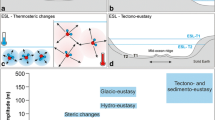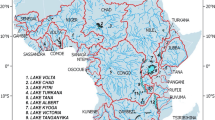Abstract—A method is proposed for constructing a regional algorithm to calculate the thickness of the euphotic zone from in situ measurements of the vertical profiles of the beam attenuation coefficient under the condition of one-parameter optical properties of water (Case-1 water). Using the proposed methodology, a regional algorithm for determining the thickness of the photic zone was developed based on the results of synchronous measurements of the beam attenuation coefficient and photosynthetically active radiation, performed in January 2022 as part of cruise 87 of the R/V Akademik Mstislav Keldysh for the northwestern Weddell Sea. For this region, an equation was obtained that can estimate the depth of the photic zone with a relative reconstruction error of 18%.



Similar content being viewed by others
REFERENCES
V. I. Vedernikov, “Features of the distribution of primary production and chlorophyll in summer,” in Variability of the Black Sea Pelagial Ecosystem and Anthropogenic Factors (Nauka, Moscow, 1991), pp. 128–147.
V. I. Zvalinsky and P. Ya. Tishchenko, “Modeling photosynthesis and the growth of marine phytoplankton,” Oceanology 56 (4), 527–539 (2016).
K. Ya. Kondrat’ev and P. P. Fedchenko, “Influence of the solar radiation spectrum on the evolution of the biosphere,” Vestn. Ross. Akad. Nauk 75 (6), 522–532 (2005).
V. I. Man’kovskii and P. P. Sherstyankin, “Using hydrooptical characteristics to control the state of the ecosystem of water bodies,” Geogr. Prirod. Resurs., No. 3, 86–94 (2019). https://doi.org/10.21782/GIPR0206-1619-2019-3(86-94)
N. A. Moiseeva, T. Ya. Churilova, T. V. Efimova, and D. N. Matorin, “Correction of fluorescence quenching of chlorophyll a in the upper mixed layer of the sea: Development of an algorithm,” Mor. Gidrofiz. Zh. 36 (1), 66–74 (2020).
E. G. Morozov, M. V. Flint, A. M. Orlov, et al., “Oceanographic and ecosystem studies in the Atlantic sector of Antarctica (cruise 87 of the research vessel Akademik Mstislav Keldysh),” Oceanology 62 (5), 721–723 (2022).
A. V. Prazukin, A. A. Latushkin, Yu. K. Firsov, and A. A. Chepyzhenko, “Vertical distribution of photosynthetically active radiation in the canopy of Zostera noltii Hornemann at different heights of the Sun above the horizon,” Optics of the Atmosphere and the Ocean. Atmospheric Physics: Proc. XXVII Int. Symp., Moscow, July 5–9, 2021 (Izd. IOA SO RAN, Tomsk, 2021), pp. S330–S333. https://symp.iao.ru/files/symp/aoo/27/C.pdf.
V. V. Suslin, T. Ya. Churilova, A. A. Latushkin, et al., “Photosynthetically active radiation at the bottom of the northwestern shelf of the Black Sea based on regional models and satellite data and its interannual variability,” Fundam. Prikl. Gidrofiz. 13 (3), 68–77 (2020). https://doi.org/10.7868/S2073667320030053
Kh. G. Tooming and B. I. Gulyaev, Method for Measuring Photosynthetically Active Radiation (Nauka, Moscow, 1967) [in Russian].
A. I. Chepyzhenko and A. A. Chepyzhenko, “Instrumental means of biophysical monitoring of the World Ocean,” Materials of the 15th All-Russian Scientific and Technical Conference “Modern Means of Oceanological Research” MSOI-2017, Moscow (2017), Vol. 2, pp. 45–49. https://doi.org/10.33075/2220-5861-2020-1-95-101
A. I. Chepyzhenko and A. A. Chepyzhenko, “Methods and means of environmental monitoring in situ of the parameters of the state of the aquatic environment and anthropogenic load,” in Collection of Articles of the Scientific and Practical Conference with International Participation “Environmental, Industrial and Energy Security 2017”, September 11–15, 2017 (Inst. Yad. Energii Prom-sti, Sevastopol, 2017), pp. 1491–1495 [in Russian].
H. M. Dierssen and R. C. Smith, “Case 2 Antarctic coastal waters: The bio-optical properties of surface meltwater,” in Proceedings Ocean Optics XV, Ed. by S. Ackleson and J. Marra (Nav. Res., Kailua-Kona, Hawaii, 2000).
H. M. Dierssen and R. C. Smith, “Bio-optical properties and remote sensing ocean color algorithms for Antarctic Peninsula waters,” J. Geophys. Res.: Oceans 105 (C11), 26301–26312 (2000a).
A. Ferreira, A. C. Brito, C. R. Mendes, et al., “OC4-SO: A new chlorophyll-a algorithm for the western Antarctic Peninsula using multi-sensor satellite data,” Remote Sens. 14 (5), 1052 (2022). https://doi.org/10.3390/rs14051052
A. Ferreira, A. M. Ciotti, and C. A. Garcia, “Bio-optical characterization of the northern Antarctic Peninsula waters: Absorption budget and insights on particulate backscattering,” Deep-Sea Res. II 149, 138–149 (2018).
H. R. Gordon and W. R. McCluney, “Estimation of the depth of sunlight penetration in the sea for remote sensing,” Appl. Opt. 14, 413–416 (1975). https://doi.org/10.1364/AO.14.000413
Y. Huot, B. A. Franz, and M. Fradette, “Estimating variability in the quantum yield of Sun-induced chlorophyll fluorescence: A global analysis of oceanic waters,” Remote Sens. Environ. 132, 238–253 (2013). https://doi.org/10.1016/j.rse.2013.01.003
J. T. O. Kirk, Light and Photosynthesis in Aquatic Ecosystems, 3rd ed. (University Press UK, Cambridge, 2011).
Ž. Kovač, T. Platt, S. Sathyendranath, and M. Morović, “Analytical solution for the vertical profile of daily production in the ocean,” J. Geophys. Res.: Oceans 121 (5), 3532–3548 (2016). https://doi.org/10.1002/2015JC011293
A. A. Latushkin, V. A. Artemiev, A. V. Garmashov, et al., “Variability of seawater optical properties in the adjacent water basins of the Antarctic Peninsula in January and February 2020,” in Antarctic Peninsula Region of the Southern Ocean (Springer, Cham, 2021), pp. 229–240.
LI-COR LI-192 Underwater PAR Sensor. https://www.fondriest.com/li-cor-li-192-underwater-par-sensor.htm. Accessed August 22, 2022.
C. B. Miller and P. A. Wheeler, Biological Oceanography (John Wiley and Sons, New York, 2012).
A. Morel and L. Prieur, “Analysis of variations in ocean color 1,” Limnol. Oceanogr. 22 (4), 709–722 (1977).
Ocean Productivity Home Page (2017). http://www. science.oregonstate.edu/ocean.productivity/index.php. Accessed August 22, 2022.
P. A. Salyuk, V. A. Artemiev, D. I. Glukhovets, et al., “Bio-optical models for estimating euphotic zone depth in the western Atlantic sector of the Southern Ocean in the Antarctic summer,” in Antarctic Peninsula Region of the Southern Ocean (Springer, Cham, 2021), pp. 241–250.
P. A. Salyuk, D. I. Glukhovets, A. Y. Mayor, et al., “Phycoerythrin pigment distribution in the upper water layer across the Weddell–Scotia confluence zone and Drake Passage summer,” in Antarctic Peninsula Region of the Southern Ocean (Springer, Cham, 2021), pp. 251–259.
C. Six, J. C. Thomas, L. Garczarek, et al., “Diversity and evolution of phycobilisomes in marine / Synechococcus spp.: A comparative genomics study,” Genome Biology 8 (2), R259 (2007). https://doi.org/10.1186/gb-2007-8-12-r259
M. Szeto, P. J. Werdell, T. S. Moore, and J. W. Campbell, “Are the world’s oceans optically different?,” J. Geophys. Res.: Oceans 116 (C7) (2011). https://doi.org/10.1029/2011JC007230
Funding
Expeditionary research was carried within state tasks for the following institutions: MHI RAS, topic no. FNNN-2022-0001 “Experimental Studies of the Variability of Hydrophysical, Hydrochemical, and Biooptical fields at Different Spatiotemporal Scales to Identify Specific Features of Climate Change in Oceanographic Conditions in the Atlantic Part of the Antarctic” and topic no. FNNN-2021-0003 “Development of Methods for Operational Oceanology based on Interdisciplinary Studies of the Formation and Evolution of the Marine Environment and Mathematical Modeling Using Data from Remote Sensing and Contact Measurements”; POI FEB RAS, topic no. 0211-2021-0007 “Technologies for Remote Sensing of the Earth and Ground-Based Measuring Systems in Integrated Studies of Dynamic Phenomena in the Ocean and Atmosphere” and topic no. FWMM-2022-0033 “Integrated Studies of the Environment and Climate of the Southern Ocean.” The regional algorithm was developed with the support of the Russian Science Foundation (project no. 21-77-10059).
Author information
Authors and Affiliations
Corresponding author
Rights and permissions
About this article
Cite this article
Latushkin, A.A., Salyuk, P.A., Suslin, V.V. et al. A Regional Algorithm for Calculating the Thickness of the Photic Zone from the Vertical Profile of the Beam Attenuation Coefficient with a Case Study of the Northwestern Weddell Sea. Oceanology 63, 545–549 (2023). https://doi.org/10.1134/S0001437023040082
Received:
Revised:
Accepted:
Published:
Issue Date:
DOI: https://doi.org/10.1134/S0001437023040082




